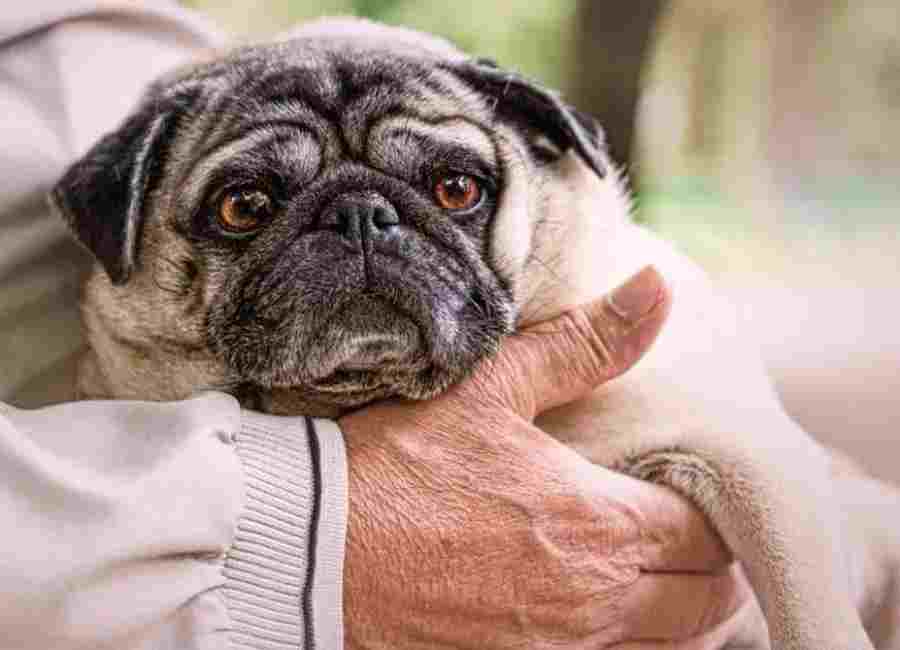9 Most Common Pug Dying Symptoms

If you’re a pug owner, it’s important to know the symptoms of Pug dying syndrome.
This is a condition that can affect pugs and other breeds of dogs, but it’s most common in toy pugs.
Most pug dying symptoms may not be obvious at first, but if you pay close attention you will notice changes.
If you notice any changes in your Pug’s behavior, such as increased anxiety or restlessness, be sure to get him checked out by a veterinarian.
Pug Dying Symptoms
The following are some common pug dying symptoms you should watch out for:
1. Continuous loss of appetite

Pugs are prone to digestive issues, and this can cause loss of appetite as a sign they are dying and needs help.
A sudden loss of appetite in your Pug may indicate various health issues. It could be linked to minor factors like stress or changes in their environment, but it could also signal more serious conditions like gastrointestinal problems, dental issues, or even organ dysfunction.
If your Pug refuses to eat or shows disinterest in their favorite treats or meals for more than a day, it’s crucial to monitor their behavior and consult your veterinarian. Timely intervention can prevent potential complications and provide the necessary treatment.
2. Discoloration of Gums or Tongue
Healthy Pug gums should have a nice pink color. If you notice any changes in the color, such as pale, bluish, or bright red gums, it could be an indication of serious health issues.
Pale gums might suggest a lack of oxygen, which could be linked to heart problems or internal bleeding. Bluish gums might signal a lack of oxygenated blood, requiring immediate attention.
Bright red gums could be a sign of inflammation or heatstroke. Monitor your Pug’s gum color regularly, as it can offer valuable insights into their overall health.
Learn more about the common causes of death in pugs.
3. Persistent Coughing
Pugs can be susceptible to respiratory infections and various respiratory disorders. If your Pug develops a cough that persists for more than a few days, it might indicate issues like kennel cough, bronchitis, or pneumonia.
Chronic coughing can also be a symptom of heart disease, especially if it gets worse during exercise or excitement. A thorough examination by a veterinarian is necessary to determine the cause and prescribe appropriate treatment.
4. Persistent Lethargy and Weakness
Pugs are known for their playful and affectionate nature, so if you notice a significant decrease in their usual activity levels, it’s a cause for concern.
Lethargy and weakness can be the result of various underlying conditions, such as infections, metabolic disorders, or heart problems.
If your Pug seems less enthusiastic about walks, playtime, or even just moving around the house, it’s essential to have them evaluated by a vet promptly.
5. Rapid Weight Loss
If your pug is losing weight rapidly and consistently, it could be a sign of illness or a sign your pug is dying.
Unintentional weight loss is a cause for concern in any dog, including Pugs. If your Pug is losing weight despite having a consistent appetite or shows no interest in food, it could be indicative of various health issues.
Potential causes might include thyroid disorders, diabetes, gastrointestinal problems, or even cancer. A thorough examination by a veterinarian can help identify the underlying cause and devise an appropriate treatment plan.
6. Complete loss of Coordination
Complete loss of coordination is one of the most common signs your pug is dying as it gets older. If your pug is having trouble walking or standing, it’s a sign that it could be suffering from a neurological disorder.
Other symptoms include difficulty jumping up on furniture, stairs, and other things that are hard for dogs to climb. Difficulty picking up toys or treats (this can also be an indicator).
Pugs’ short snouts mean they need to work harder than most dogs when trying to get their paws on something—and this leads them to problems with their balance and coordination as well!
7. Chronic Breathing Difficulty

Pugs are prone to breathing problems because of the size and shape of their nose. Breathing problems can be caused by heart disease, lung disease, or a collapsing trachea.
Chronic breathing difficulty is a common issue experienced by pugs due to their flat faces and narrow nostrils which lead to respiratory problems.
During the final stages of a pug’s life, chronic breathing difficulty can worsen, resulting in labored breathing, wheezing, and coughing. The pug may also become lethargic and lose its appetite.
As a pug’s condition deteriorates, a veterinarian may suggest humane euthanasia to prevent further suffering.
Learn more about pug health problems.
8. Persistent vomiting and diarrhea
Occasional bouts of vomiting or diarrhea can be relatively normal in dogs, but when these symptoms persist or occur frequently, it could lead to dehydration and nutrient imbalances.
Persistent vomiting and diarrhea might be caused by dietary indiscretions, infections, allergies, or more severe conditions like pancreatitis or kidney disease.
It’s crucial to keep your Pug hydrated and seek veterinary care if the symptoms don’t improve within a day or if they are accompanied by other concerning signs.
9. Seizures or Tremors
Witnessing your Pug experiencing a seizure or uncontrollable tremors can be terrifying. Seizures are often linked to neurological disorders, such as epilepsy, brain tumors, or encephalitis.
Tremors, on the other hand, can be triggered by various factors, including poisoning, metabolic disorders, or anxiety. It’s essential to remain calm during a seizure episode and ensure your Pug’s safety.
Immediately contact your veterinarian if your Pug experiences seizures or tremors for the first time, as they require urgent medical attention and evaluation.
Learn more about why your pug is shaking.
Potential Dying stages of pugs

The following are typical warning signs that your pug is eventually dying:
Last 1 month of a dying pug
You will see the following indicators of death in the final four months of an aging pug:
- Constant freezing
- Unnecessary vomiting once in a while
- Continues dehydration
- Tougher and drying skin
- Dulling eyes
- Lack of self-grooming
Last 1 week of a dying pug
The following symptoms of a dying pug might be seen during the last week:
- Chronic lethargy
- Continues reduction in weight loss
- Eye discharge
- Increased self-isolation
- Changes in respiration patterns
Last days of a dying pug
- Slowed breathing rate
- A distant look in their eyes
- Changes in body smell
- Extreme weight loss
- Complete restlessness
- Unusual freezing
- Increased self-isolation and death
Read more: 11 Common Pug Sick Symptoms.
Ways to care for a dying pug
The following are some ways to care for a dying pug:
- Get the dog some proper food and water
- Provide a comfortable place for the dog to rest
- Make sure the dog is kept warm
- Give the dog medications if needed
- Comfort the dog during its final moments
- Keep your dying pug away from all physical activities
- Make sure your dog has a peaceful and painless death.
- Give your dog plenty of love and attention.
Read more: Why Do Pugs Smell.
Ways to get over the loss of your pug
Here are some common ways to get over the loss or death of your pug:
- Talk to a trusted friend or family member about your feelings.
- Take some time for yourself to relax and de-stress.
- Participate in activities that you enjoy with your dog in mind.
- Make a memorial plaque or picture of your dog and keep it close by.
- Write a letter to your dog about your memories and feelings.
- Spend time with other dogs to help lessen your loneliness.
- Move on and get another pet.
Learn more about keeping your dog healthy.
Ways to comfort a dying pug

Here are some common ways to comfort a dying pug:
- Provide your dying pug with better food, and keep a bowl of water nearby.
- Make your pug’s surroundings peaceful and cozy.
- In case of a cold, make sure there are sufficient baby blankets available or wrap him.
- Stay away from bright lights and loud noises in your pug’s bedroom.
- To avoid shocking them, sneak up behind him or her and gently touch him.
- Give your pug smaller meals at regular intervals.
- If your pug is on medicine, make sure to visit your veterinarian.
- To suggest pain medications or homeopathic treatments, see your veterinarian.
- To make sure that your pug eats, you might give him appetite stimulants.
- Stay close at all times in case your pug needs assistance.
Related Questions
What are some common symptoms of a pug that is dying?
Some common symptoms of a dying pug include difficulty breathing, loss of appetite, lack of energy, vomiting, and diarrhea.
How can I tell if my pug is in pain?
Signs that your pug may be in pain include excessive panting, restlessness, limping, and sensitivity to touch.
Learn more about identifying a dog in pain.
Is it normal for my pug to sleep a lot?
Yes, pugs are known for being lazy and can sleep up to 14 hours a day. However, if your pug is sleeping more than usual and is showing other symptoms like lack of appetite or trouble breathing, it’s important to take them to the vet.
What should I do if I suspect my pug is dying?
If you suspect your pug is dying, take them to the vet immediately. A vet can examine your pug and provide guidance on how to make them as comfortable as possible during their final days.
Can I prevent my pug from dying?
While death is a natural part of life, there are steps you can take to ensure your pug lives a healthy and happy life. These include providing a nutritious diet, regular exercise, routine vet check-ups, and avoiding exposure to harmful substances.
Should I consider euthanasia for my dying pug?
This is a personal decision that should be made after serious consideration of your pug’s quality of life. Speaking with a vet can provide insight into whether or not euthanasia is the best option for your pug’s health and well-being.
Learn more about identifying a dying dog and comforting a dying dog.
Conclusion
If your pug is showing any of these symptoms, it’s important to take them to the vet.
While it’s possible that a simple change in diet or lifestyle could solve this problem without medication
often times there are underlying issues that need to be addressed before you can make any progress with your dog.
